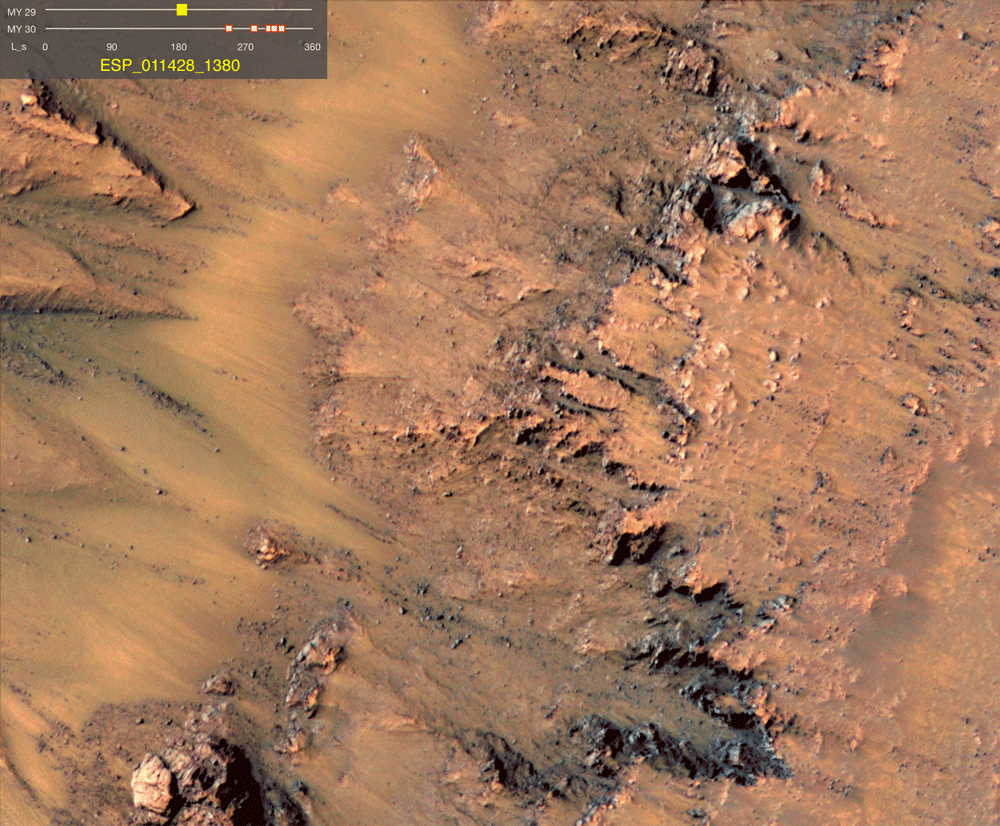Cause of mysterious dark streaks on Mars found

Evidence of landslides on Mars may also raise the prospects that the Red Planet was once hospitable to life.
A new study, published Feb. 3 in the journal Science Advances, found that melting ice is combining with the Red Planet's salty subsurface permafrost, resulting in a chemical reaction that creates a "liquid-like flowing slush." Scientists think this slush causes landslides that leave dark, narrow lines known as recurring slope lineae (RSL) on the Martian surface. While the icy slush is currently too salty to harbor life, that may not have been the case 2 billion to 3 billion years ago, the study's lead author Janice Bishop, a senior research scientist at the SETI Institute, told Live Science in an email.
Scientists have known about the landslides, some of which occur near Mars' Palikir and Krupac craters, for at least a decade, Bishop said. During that period, NASA's High Resolution Imaging Experiment (HiRISE) camera captured images of small landslides, known as "slumps," and the RSLs, which she believes are features of landslides.
Related: Here's what NASA's Opportunity rover saw before 'lights out'
Previous studies suggested those dark lines on the surface were related only to the chemical reaction between the underground chlorine salts and a large amount of sulfate. The new research takes that idea and expands it to include the permafrost, resulting in brine, or water with a high concentration of salt.
It's possible the chemical reactions between the sulfate and salt crystals are leading to expansion and migration of the salt crystals through the soil; but Bishop said that this would be a "very slow process," due to the cold temperatures on Mars, which can dip to minus 80 degrees Fahrenheit (minus 62 degrees Celsius) on the Martian surface, where the streaks are located.
While the slumps and RSLs have been going on for several decades, some of the images recently released by HiRISE show changes occurring in just a few months, Bishop told Live Science.
Sign up for the Live Science daily newsletter now
Get the world’s most fascinating discoveries delivered straight to your inbox.
The scientists performed lab experiments on sulfates, chloride salts, ice particles and volcanic ash obtained from a few Mars-like places on Earth: the McMurdo Dry Valleys in Antarctica, Israel's Dead Sea and the Salar de Pajonales in the Atacama Desert. The mixture was frozen at temperatures similar to those on Mars (minus 58 F, or minus 50 C), before melting once temperatures increased.
Under cold temperatures, the chlorine salt and sulfate separated, with the ice water moving between the mixture "almost like passing a soccer ball down the field," resulting in soil degradation and landslides, according to a statement.
Additional experiments showed a similar interaction between the sulfate and chloride moving through the Mars-analagous soil.
Raina Gough, a chemistry professor at the University of Colorado, Boulder, who was was not affiliated with the study, told Live Science that the new study solves the "replenishment" problem other studies on the Martian landslides have run into; With this new finding, "the salts and water don't need to be recharged [or replenished] seasonally, because most of the action involving the brines is in the subsurface."
The new images show that "that most of the salt and water does not travel downhill with the landslide of dry grains," Gough added.
Although Mars does not presently contain life as we know it, similar conditions have been found on Earth, particularly in Antarctica, where shrimp and other sea creatures live, according to Quartz.
"We don't know yet how the early habitable Mars transformed to modern Mars with a harsh, cold and dry environment," Bishop added.
But it's possible that the environment just below the surface of the Red Planet was habitable much longer than the Martian surface was.
Gough, whose research focuses on the formation of saltwater on the Red Planet, added that it's tricky to definitively prove whether the landslides are associated with salts and brine water. She explained that orbiting spacecraft can only see the Martian surface from space and mentioned two other recent studies that may have disproved the link between RSLs and chlorine salts, as put forth by the Bishop-led study.
It's possible these conditions could have once been home to life on Mars, Gough said. "There are organisms that do like saltwater," but it's likely the present-day conditions are "too salty to be habitable, given what we know about the limits for life on Earth."
Next, Bishop and colleagues hope to run more experiments to further analyze what happens when ice grains in the Martian soils that are mixed with a variety of different sulfates and salts are thawed.
Originally published on LiveScience.

Chris is the technology editor at Seeking Alpha, a crowd-sourced content service for financial markets. Before that, he led the U.S. science and technology desk at the Daily Mail; he was also a technology features reporter at Fox News. In addition to writing for Live Science, Chris has also written for TheStreet and Investopedia. Chris has a bachelor’s degree in finance from Seton Hall University.
